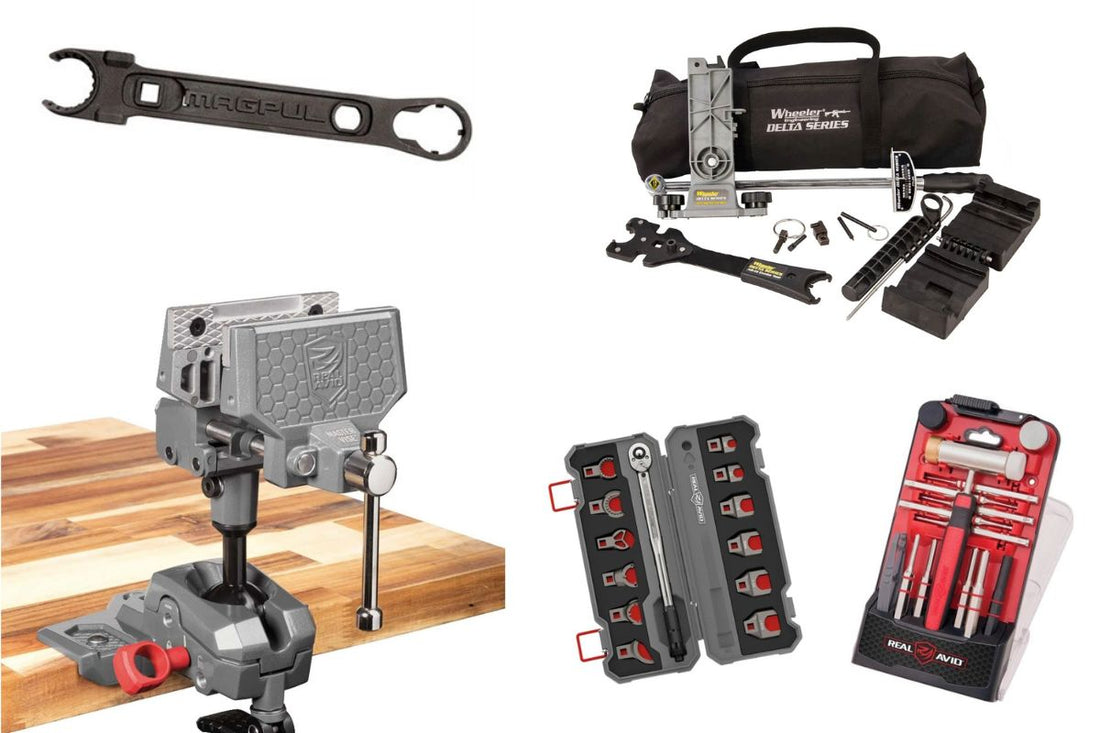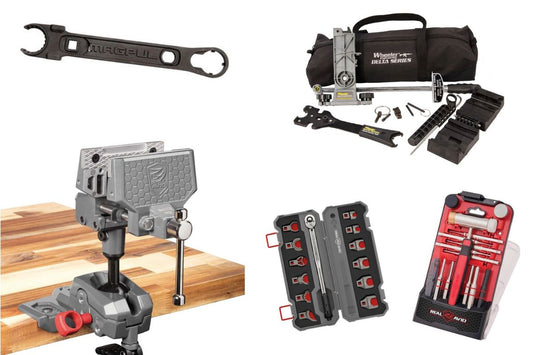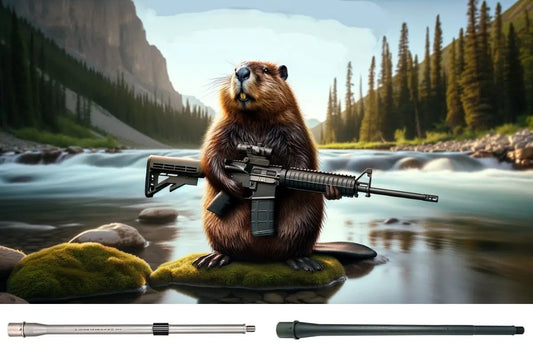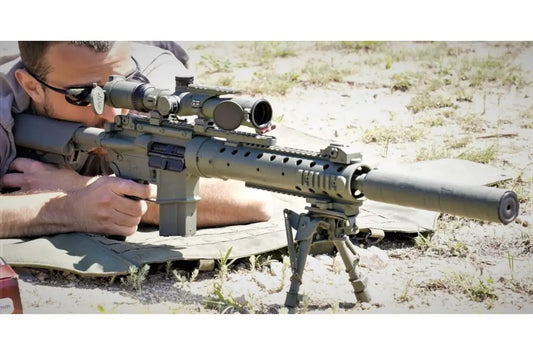
AR-15 Barrel Swap Toolkit: The Pro-Grade Gear You Actually Need
TL;DR for Skimmers
You’ll want: a rock-solid bench vise + a proper upper-receiver support (Magpul BEV Block, Real Avid Lug-Lok, or Wheeler upper block), a quality armorer’s wrench (Magpul is the benchmark), a calibrated torque solution that actually reaches barrel-nut territory (Real Avid Master-Fit ft-lb system), anti-seize for threads, and a gas-tube alignment tool (often in Wheeler kits). Add a roll-pin punch/hammer set for gas block work. Avoid impact wrenches and follow the barrel/handguard maker’s torque spec—no guesswork.
Summary table (quick pick list)
|
Purpose |
Best-in-class tool |
Budget/alt. |
Why it matters |
|
Lock the upper safely |
Magpul BEV Block (AR15/M4) |
Wheeler Upper Vise Block (Delta Series) |
Prevents receiver damage and keeps things aligned while you work |
|
Clamp to bench |
Real Avid Master Gun Vise |
Wheeler Delta AR Armorer’s Vise |
Rigid, repeatable clamping = cleaner torque application |
|
Remove/Install barrel nut |
Magpul Armorer’s Wrench (fits GI & pin-style nuts) |
TruGlo or Breakthrough Clean armorer’s wrenches |
Correct engagement surfaces minimize slippage & marring |
|
Apply correct torque |
Real Avid Master-Fit Torque Wrench + AR-15 Crowfoot Set (10–150 ft-lb system) ( |
Wheeler kits that include torque wrench (AR-15 Essential Kit) |
Repeatable torque, correct crow’s feet for modern barrel nuts |
|
Hold via barrel extension (alt. to clamshell) |
Real Avid Lug-Lok Upper Vise Block |
— |
Transfers load through the barrel extension lugs instead of receiver walls |
|
Align gas system |
Gas-tube alignment tool (included in Wheeler AR-15 kits) |
— |
Speeds correct gas block/tube alignment |
|
Protect threads |
Anti-seize (Breakthrough Clean Anti-Sieze Grease) |
CVA Anti-Seize Stick (easy, mess-free) ( |
Helps prevent galling and future stuck nuts |
|
Small strikes & pins |
Real Avid Accu-Punch hammer + roll-pin set (AR-15 punches available) |
— |
Cleanly install/remove gas block/tube pins without mushrooming |
“The BEV Block is an all-in-one compact vise block tool for AR-15/M4 assembly operations of barrel nuts, flash hiders, etc.” — Magpul product note
The Core Tools (and why pros insist on them)
1) A rigid bench vise (and a purpose-built gun vise)
You can’t apply precise torque if your workholding is flexing. A stout bench-mounted vise is table stakes; pairing it with a firearm-specific vise transforms the experience.
- Pick: Real Avid Master Gun Vise — ultra-adjustable, reversible steel jaws, clever locking pins that integrate with Real Avid’s Lug-Lok block. If you swap uppers more than once a year, it’s worth it.
- Alt.: Wheeler Delta AR Armorer’s Vise — a simpler, versatile option that still gives you a stable base.
Pros
- Locks work at repeatable angles; reduces “tool walk” while torquing.
- Faster setup between ops (nut removal → alignment → re-torque).
Cons
- Costs more than a generic bench vise.
- Footprint: you’ll want a dedicated bench corner for clean leverage.
2) Receiver support: clamshells are fine, but extension-based blocks are better
Modern best practice is to carry the load through the barrel extension rather than squeezing the receiver shell. That’s what BEV-style or Lug-Lok blocks do.
- Pick: Magpul BEV Block — compact, robust, and it supports from both the barrel extension and the magwell (via an included pin). Excellent with standard GI nuts and many modern variations.
- Alt.: Real Avid Lug-Lok — engages the barrel lugs directly, “rendering clamp-style blocks obsolete” in their words; it’s a secure, receiver-friendly hold.
- Budget/legacy: Wheeler Upper Vise Block — still effective, now often bundled with a gas-tube aligner. Best when you’re careful with torque and use a perfectly fitted clamshell.
“I was unable to remove the barrel nuts due to the excessive torque.” — Chad Albrecht, School of the American Rifle, on poorly assembled uppers. It’s a cautionary tale about over-torqueing and sketchy setups.
Pros
- BEV/Lug-Lok keeps the receiver from taking shear loads; minimizes risk of egging or cracking.
- Better “feel” while you torque — alignment stays truer.
Cons
- Some exotic handguard systems can be fussy with certain fixtures.
- Blocks add upfront cost compared to a bare clamshell.
3) An armorer’s wrench that actually fits your nut
Barrel nuts vary (GI, pin-style, proprietary flats). You want hard steel, precise engagement, and a non-slip phosphate or similar finish.
- Pick: Magpul Armorer’s Wrench — American-made, solid steel, engages both stock and pin-style barrel nuts and standard flash hiders. It’s the “buy once, cry once” option.
- Alts.: TruGlo AR-15 Armorer’s Wrench (value pick), Breakthrough Clean Armorer’s AR-15 Wrench (titanium-plated stainless). Both work; neither matches Magpul’s ergonomics and tooth geometry in my experience.
- System approach: Real Avid Armorer’s Master Wrench plays well with their Master-Fit crowfoot set; nice when you’re juggling proprietary nuts across brands.
Pros
- Correct tooth pattern prevents cam-out and chewed nuts.
- One wrench covers castle nuts and muzzle devices too (Magpul).
Cons
- Some rail makers require a dedicated crowfoot; a universal wrench can’t solve that.
4) Torque the right way: real ft-lb capability + AR-specific crow’s feet
Inch-pound drivers (e.g., Wheeler F.A.T. Wrench/Digital F.A.T.) are great for optics, not for barrel nuts. For barreling work, you want a 1/2-inch drive torque solution that accepts AR-specific crowfeet.
- Pick: Real Avid Master-Fit Torque Wrench + 13-Piece AR-15 Crowfoot Set — purpose-built crow’s feet for popular barrel nuts and a torque wrench covering typical barrel-nut ranges. It’s the cleanest way to apply manufacturer specs accurately.
- Kit route: Wheeler Delta Series AR-15 Armorer’s Essential Kit includes a torque wrench, armorer’s wrench, and an upper block with gas-tube aligner — solid value if you’re outfitting from scratch.
Pros
- Repeatable torque with the correct adapter geometry — no math games.
- Crow’s feet reach modern low-profile nuts under handguards.
Cons
- Costlier than a generic auto torque wrench (which often can’t accept AR-specific crow’s feet anyway).
- Calibrate periodically if you’re a high-volume tinkerer.
NOTE: Barrel-nut torque windows vary by nut/rail maker. Always follow your manufacturer’s spec rather than internet one-size-fits-all numbers.
5) Anti-seize on threads = future-you says thanks
Dry steel-on-aluminum loves to gall. A dab on the receiver threads and barrel nut face (exactly as your maker recommends) helps installation and serviceability down the line.
- Pick: Breakthrough Clean Anti-Seize Grease (syringe-style) — easy application, purpose-built for firearms environments.
- Mess-free alt.: CVA Anti-Seize Stick — stick applicator is tidy for intermittent use.
Pros
- Reduces thread galling and “welded-on” nuts.
- Helps achieve more consistent torque feel.
Cons
- Over-application can migrate; keep it off the chamber/barrel extension face.
6) Gas system helpers: alignment tools, punches, and a small hammer
If your gas block uses a roll pin, you’ll want a proper roll-pin punch set and a light gunsmith’s hammer. A gas-tube alignment tool (often included in Wheeler kits) simplifies lining up the block and tube before you secure the handguard.
- Punch/hammer pick: Real Avid Accu-Punch (or their AR-15-specific punch kit) — good handles and properly ground roll-pin tips.
- Alignment tool: Included with Wheeler Upper Vise Block/Essential Kit — quick, visual check that your gas path is straight before you button up.
Pros
- Cleaner, straighter installs; fewer mangled pins.
- Alignment tools catch misalignment before it causes short-stroking.
Cons
- Another small tool to store; easy to misplace if you’re not organized.
“Nice to have” add-ons that feel like cheating (in the best way)
- AR-specific work mat (keeps springs and set screws visible): e.g., Scheels Outfitters AR-15 TekMat.
- Chamber & bore brush combo (to clean before reassembly): Real Avid AR-15 .223/5.56 chamber/bore brush.
- Complete armorer kits when you’re starting from zero:
- Real Avid AR15 Armorer’s Master Kit (soup-to-nuts tooling for builds, swaps, and service).
- Wheeler AR-15 Armorer’s Kit (18-piece set tailored for the DIY builder).
Pros
- Fewer trips back to the store mid-project.
- Tooling coherence — wrenches, blocks, and crowfeet designed to work together.
Cons
- Kits may include tools you’ll rarely use (pay for completeness).
What not to do (non-obvious safety notes)
- Skip the impact driver. High-torque battery impacts (Milwaukee/DeWALT) are phenomenal for automotive work — but they apply pulsed torque with poor tactile feedback. That’s a recipe for over-torque. Use a calibrated hand torque wrench for barrel nuts; save the impacts for lug nuts.
- Don’t clamp the bare barrel to torque your nut. Aside from marring, you risk loading the index pin and receiver threads in ways the system wasn’t designed to handle; upper-support blocks or barrel-extension fixtures distribute the load correctly. (Gunsmiths debate methods, but extension-based support is the current best practice.)
- Avoid inch-pound drivers for barrel nuts. Tools like the Wheeler F.A.T. Wrench are excellent for optics ring screws and small fasteners — not for barrel nuts. If you only own an in-lb driver, that’s your sign to upgrade to a ft-lb system for this job.
Minimalist loadout vs. premium bench: what’s right for you?
Minimalist “one-and-done” set (budget-conscious)
- Wheeler Upper Vise Block (with gas-tube aligner).
- Magpul Armorer’s Wrench.
- Wheeler Essential Kit (gets you the torque wrench and extras in one box).
- Breakthrough Clean Anti-Seize Grease.
- Real Avid Accu-Punch set.
Pros: Lowest cost to do it correctly once, no corner-cutting on torque or support.
Cons: Clamshell-style upper block transmits some load to the receiver walls; mind your technique.
Premium “armorer-grade” bench (repeat users, high-end rails)
- Real Avid Master Gun Vise + Lug-Lok upper block.
- Magpul BEV Block on hand for odd jobs.
- Magpul Armorer’s Wrench and Real Avid Master-Fit Crowfoot Set with torque wrench (covers proprietary nuts).
- Breakthrough Clean Anti-Seize.
- Real Avid Accu-Punch (or their AR-15 punch kit).
Pros: Best-in-class workholding, precise engagement on every modern nut, quickest workflow.
Cons: Higher up-front cost; you’ll never want to go back.
Expert voices & good arguments
- On over-torque and setup: School of the American Rifle’s Chad Albrecht has repeatedly documented factory uppers with nuts torqued so hard that removal is a chore. It’s not about “gorilla tight” — it’s about correct spec + proper fixture.
- On receivers vs. barrels for load path: The AR community’s consensus reasoning is that clamping by the receiver (with proper support) or the barrel extension provides more surface area and avoids stressing the little index pin; clamping the thin barrel risks damage or rotation.
- On tooling geometry: Many barrel-nut designs require crowfoot adapters rather than simple castle-nut hooks. That’s why AR-specific crowfoot sets (Real Avid’s) exist — they keep leverage co-planar and torque readings meaningful.
Frequently missed details that separate pro work from “YouTube close”
- Use the right crowfoot, oriented correctly on your torque wrench so you’re not unintentionally extending the lever arm and mis-torquing. (The proper AR crowfeet solve this by design.)
- Clean, lightly lubricated threads behave predictably. Dirty, dry threads are why “identical torque” gives inconsistent alignment. Anti-seize used sparingly keeps things honest.
- Verify gas-tube alignment before final button-up; many “mystery short-stroke” calls trace back to a rotated gas block or kinked tube. Alignment tools in the Wheeler kits make this a 30-second check.
- Receiver protection: If you still like clamshell blocks, make sure they’re perfectly matched to your upper profile; play equals crush points under torque. Wheeler’s updated block is improved here.
Checklist: everything to put in your cart
- Bench/Workholding
- Receiver/Upper supports
- Magpul BEV Block — AR15/M4.
- Real Avid Lug-Lok Upper Vise Block (barrel-extension hold).
- Wheeler Upper Vise Block (includes gas-tube aligner).
- Wrenches & torque
- Magpul Armorer’s Wrench.
- Real Avid Master-Fit Torque Wrench + AR-15 Crowfoot Set.
- Wheeler AR-15 Armorer’s Essential Kit (torque wrench + tools in one).
- Consumables & small tools
- Breakthrough Clean Anti-Seize Grease.
- CVA Anti-Seize Stick (clean applicator).
- Real Avid Accu-Punch hammer + roll-pin set (or AR-15 punch kit).
- Real Avid .223/5.56 chamber & bore brush combo (clean before reassembly).
- AR-15 work mat (TekMat, etc.) to protect finish and catch small parts.
Final word
If you’re going to do barrel swaps at home, invest in workholding and torque first. You can make do with a mid-tier wrench, but you can’t fake a rigid setup or accurate torque delivery. The Magpul BEV Block + Magpul Armorer’s Wrench and a true ft-lb torque system with AR-specific crowfeet (Real Avid’s Master-Fit) will pay you back every time you spin a nut. Add anti-seize and a gas-tube alignment tool, and you’ll avoid 90% of the headaches we see on the bench.
Important: This article focuses on tools and setup only. Always follow your barrel and handguard manufacturer’s procedures and torque specs. If anything feels wrong, stop and consult a qualified gunsmith.




